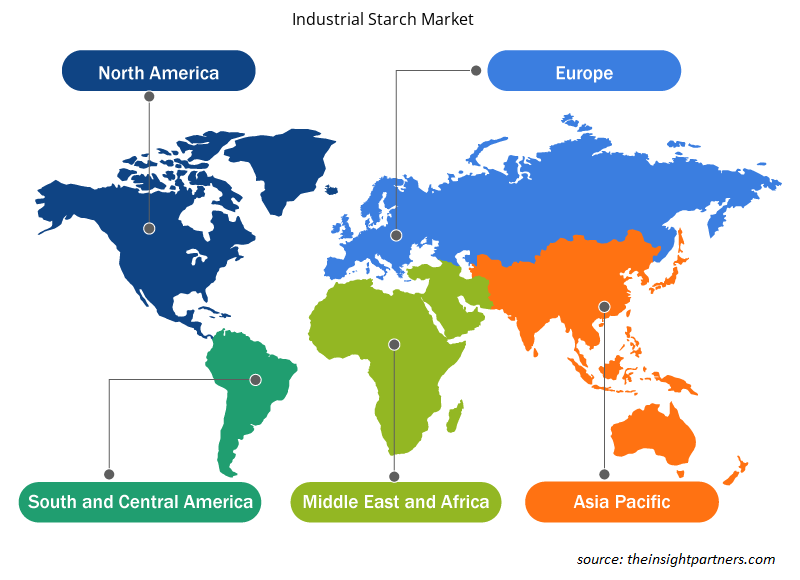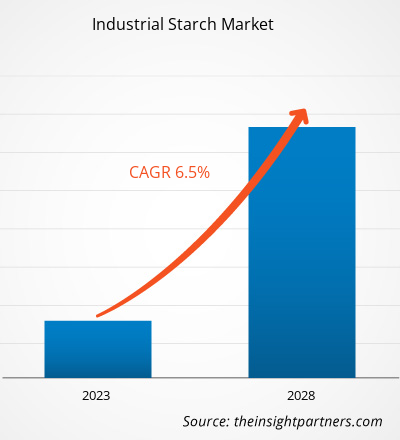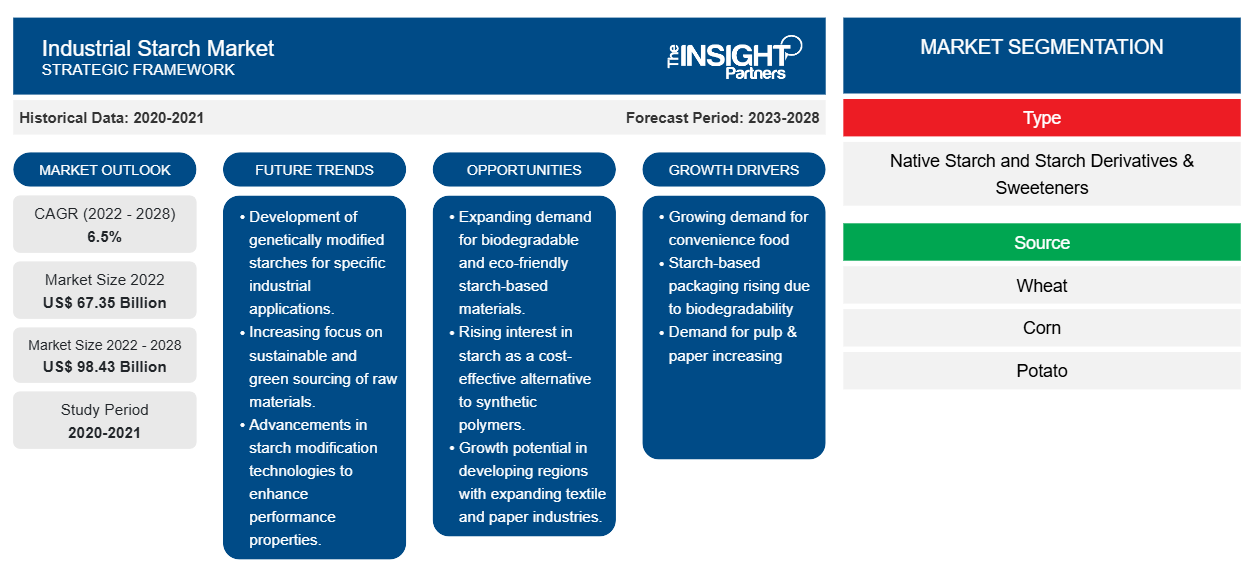[تقرير بحثي] من المتوقع أن ينمو سوق النشا الصناعي من 67،353.01 مليون دولار أمريكي في عام 2022 إلى 98،426.74 مليون دولار أمريكي بحلول عام 2028؛ ومن المتوقع أن ينمو بمعدل نمو سنوي مركب قدره 6.5٪ من عام 2022 إلى عام 2028.CAGR of 6.5% from 2022 to 2028.
النشا هو كربوهيدرات معقدة مشتقة من القمح والذرة والبطاطس والتابيوكا والأرز. إنه مصدر رائع للطاقة. النشا هو عامل تكثيف/تجلط ومثبت في مجموعة واسعة من الأطعمة والمشروبات، بما في ذلك منتجات المخابز والحلويات والحساء والصلصات والحلويات المجمدة وكريمة الألبان والمشروبات الجاهزة للشرب. يتزايد الطلب على الأطعمة الجاهزة عالميًا بسبب أنماط الحياة المحمومة للمستهلكين وارتفاع دخل الفرد. علاوة على ذلك، تحتاج عبوات الأطعمة الورقية إلى طلاء لمنع الماء أو الأكسجين من اختراق العبوة وإفساد المواد الغذائية الموجودة بداخلها. عادة، يتم تصنيع هذا الطلاء الواقي من البلاستيك القائم على البترول. ومع ذلك، يتبنى المصنعون مواد خام قائمة على المواد الحيوية والصديقة للبيئة لطلاء عبوات الأطعمة الورقية مع زيادة الوعي بالتأثير السلبي للبلاستيك القائم على البترول على البيئة. تعمل خصائص التغليف القائمة على النشا مثل القدرة على التحلل البيولوجي والقدرة على تحمل التكاليف على تعزيز الشعبية بين المصنعين.
في السنوات القليلة الماضية، نما الطلب على النشا في صناعة اللب والورق بشكل كبير مع توسع العمليات في هذه الصناعة. تساهم صناعة التجارة الإلكترونية المزدهرة بشكل كبير في الطلب على الورق المقوى المموج. علاوة على ذلك، فإن التحول الملحوظ نحو التغليف الخالي من البلاستيك لضمان الاستدامة البيئية يدفع الطلب على مواد التغليف المستدامة. وفقًا لبحث أجرته شركة Roquette Frères، زاد استهلاك النشا الصناعي في تصنيع الورق المقوى المموج بنسبة 6٪ في عام 2020 بسبب الارتفاع الكبير في قطاع التجارة الإلكترونية وسط جائحة COVID-19. وبالتالي، فإن الطلب المتزايد على النشا في صناعة الورق والورق المقوى يعزز سوق النشا الصناعيpaperboards. Moreover, a notable shift toward plastic-free packaging to ensure environmental sustainability is propelling the demand for sustainable packaging materials. According to research conducted by Roquette Frères, the consumption of industrial starch in corrugated board manufacturing increased by 6% in 2020 due to the significant rise of the e-commerce sector amid the COVID-19 pandemic. Thus, the surging demand for starch in the paper & paperboard industry is bolstering the
قم بتخصيص هذا التقرير ليناسب متطلباتك
ستحصل على تخصيص لأي تقرير - مجانًا - بما في ذلك أجزاء من هذا التقرير، أو تحليل على مستوى الدولة، وحزمة بيانات Excel، بالإضافة إلى الاستفادة من العروض والخصومات الرائعة للشركات الناشئة والجامعات
-
احصل على أهم اتجاهات السوق الرئيسية لهذا التقرير.ستتضمن هذه العينة المجانية تحليلاً للبيانات، بدءًا من اتجاهات السوق وحتى التقديرات والتوقعات.
يستفيد المصنعون في جميع أنحاء العالم من نمو صناعة التجارة الإلكترونية. في جميع أنحاء العالم، تعمل العديد من الشركات المصنعة وقنوات التجارة الإلكترونية على الترويج لاستخدام مواد التغليف المستدامة والصديقة للبيئة. ومن المتوقع أن يتعزز نمو سوق النشا الصناعي مع هذا التبني المتزايد لمواد التغليف المستدامة من قبل صناعة التجارة الإلكترونية. تبنت شركتا التجارة الإلكترونية الهنديتان ماينترا وفليبكارت تقليل أو القضاء على استخدام البلاستيك للاستخدام مرة واحدة في مواد التغليف الخاصة بهما. علاوة على ذلك، من المتوقع أن تعزز سياسات الحكومة للحد من تلوث البلاستيك الطلب على النشا الصناعي.benefitting from the growth of the e-commerce industry. Across the globe, various manufacturers and e-commerce channels are promoting the use of sustainable and eco-friendly packaging materials. The industrial starch market growth is expected to boost with this increasing adoption of Myntra and Flipkart have adopted to reduce or eliminate the use of single-use plastic in their packaging materials. Moreover, government policies to reduce plastic pollution is expected to boost the demand for industrial starch.
رؤى السوق
نطاق التطبيق الواسع للنشا الصناعي يغذي نمو السوق
لقد توسع نطاق تطبيق النشويات الصناعية في مختلف الصناعات النهائية في السنوات الأخيرة. يتم استخدامه كعامل تكثيف وتكوين هلام وربط في مجموعة واسعة من الأطعمة والمشروبات، بما في ذلك المخبوزات والحساء وخلطات السلطة والحلويات والصلصات والآيس كريم ومشروبات الفاكهة ومنتجات الألبان. يستخدم النشا أيضًا في التطبيقات غير الغذائية مثل اللب والورق والأدوية والأعلاف الحيوانية. في صناعة الأدوية، يتم استخدام النشا كعامل مساعد وعامل ربط في صناعة الأقراص. علاوة على ذلك، تعد المواد القائمة على النشا حلاً مثاليًا لمواد تغليف الأغذية القابلة للتحلل البيولوجي والتي تساعد في تقليل التلوث البيئي.
رؤى النوع
بناءً على النوع، يتم تقسيم سوق النشا الصناعي إلى النشا الأصلي ومشتقات النشا والمحليات. في عام 2021، هيمن قطاع مشتقات النشا والمحليات على السوق. الطلب المتزايد على الأغذية والمشروبات، بسبب زيادة مستويات الدخل المتاح وزيادة عدد السكان العالميين، واستخدام مشتقات النشا في صناعات الأغذية والمشروبات هو المحرك الأكثر أهمية للنمو لقطاع مشتقات النشا في سوق النشا الصناعي.
تعد Agrana Beteiligungs-AG؛ وADM؛ وIngredion Incorporated؛ وRoquette Frères؛ وTereos Group؛ وCargill, Incorporated؛ وTate & Lyle PLC؛ وGrain Processing Corporation؛ وRoyal Cosun؛ وAVEBE من بين اللاعبين الرئيسيين العاملين في سوق النشا الصناعي. يتبنى اللاعبون الرائدون العديد من الاستراتيجيات، مثل عمليات الدمج والاستحواذ وإطلاق المنتجات، لتوسيع حضورهم الجغرافي وقاعدة المستهلكين. Beteiligungs-AG; ADM; Ingredion Incorporated; Roquette Frères; Tereos Group; Cargill, Incorporated; Tate & Lyle PLC; Grain Processing Corporation; Royal Cosun; and AVEBE are among the key players operating in the industrial starch market. The leading players adopt several strategies, such as mergers & acquisitions and product launches, to expand their geographic presence and consumer base.
تقرير يسلط الضوء على
- الاتجاهات التقدمية في صناعة النشا الصناعي لمساعدة اللاعبين على تطوير استراتيجيات فعالة طويلة الأجل
- استراتيجيات نمو الأعمال التي تتبناها الشركات لضمان النمو في الأسواق المتقدمة والنامية
- التحليل الكمي لسوق النشا الصناعي العالمي من 2021 إلى 2028
- تقدير الطلب على النشا الصناعي عبر مختلف الصناعات
- تحليل قوى بورتر الخمس لتوضيح فعالية المشترين والموردين العاملين في صناعة النشا الصناعي
- التطورات الأخيرة لفهم سيناريو السوق التنافسية والطلب على النشا الصناعي
- اتجاهات السوق وتوقعاتها إلى جانب العوامل التي تحكم نمو سوق النشا الصناعي
- فهم الاستراتيجيات التي تدعم المصلحة التجارية فيما يتعلق بنمو السوق، مما يساعد في عملية اتخاذ القرار
- حجم سوق النشا الصناعي في مختلف عقد السوق
- نظرة عامة مفصلة وتقسيم السوق بالإضافة إلى ديناميكيات صناعته
- حجم سوق النشا الصناعي في مناطق مختلفة مع فرص نمو واعدة
رؤى إقليمية حول سوق النشا الصناعي
لقد قام المحللون في Insight Partners بشرح الاتجاهات والعوامل الإقليمية المؤثرة على سوق النشا الصناعي طوال فترة التوقعات بشكل شامل. يناقش هذا القسم أيضًا قطاعات سوق النشا الصناعي والجغرافيا في جميع أنحاء أمريكا الشمالية وأوروبا ومنطقة آسيا والمحيط الهادئ والشرق الأوسط وأفريقيا وأمريكا الجنوبية والوسطى.

- احصل على البيانات الإقليمية المحددة لسوق النشا الصناعي
نطاق تقرير سوق النشا الصناعي
| سمة التقرير | تفاصيل |
|---|---|
| حجم السوق في عام 2022 | 67.35 مليار دولار أمريكي |
| حجم السوق بحلول عام 2028 | 98.43 مليار دولار أمريكي |
| معدل النمو السنوي المركب العالمي (2022 - 2028) | 6.5% |
| البيانات التاريخية | 2020-2021 |
| فترة التنبؤ | 2023-2028 |
| القطاعات المغطاة |
حسب النوع
|
| المناطق والدول المغطاة |
أمريكا الشمالية
|
| قادة السوق وملفات تعريف الشركات الرئيسية |
|
كثافة اللاعبين في سوق النشا الصناعي: فهم تأثيرها على ديناميكيات الأعمال
يشهد سوق النشا الصناعي نموًا سريعًا، مدفوعًا بالطلب المتزايد من المستخدم النهائي بسبب عوامل مثل تفضيلات المستهلكين المتطورة والتقدم التكنولوجي والوعي المتزايد بفوائد المنتج. ومع ارتفاع الطلب، تعمل الشركات على توسيع عروضها والابتكار لتلبية احتياجات المستهلكين والاستفادة من الاتجاهات الناشئة، مما يؤدي إلى زيادة نمو السوق.
تشير كثافة اللاعبين في السوق إلى توزيع الشركات أو المؤسسات العاملة في سوق أو صناعة معينة. وهي تشير إلى عدد المنافسين (اللاعبين في السوق) الموجودين في مساحة سوق معينة نسبة إلى حجمها أو قيمتها السوقية الإجمالية.
الشركات الرئيسية العاملة في سوق النشا الصناعي هي:
- مجموعة AGRANA
- أدم
- شركة إنجريديون المحدودة
- روكيت فرير
- مجموعة تيروس
إخلاء المسؤولية : الشركات المذكورة أعلاه ليست مرتبة بأي ترتيب معين.

- احصل على نظرة عامة على أهم اللاعبين الرئيسيين في سوق النشا الصناعي
"تحليل سوق النشا الصناعي حتى عام 2028" هو دراسة متخصصة ومتعمقة لصناعة المواد الكيميائية والمواد، مع التركيز على تحليل اتجاه السوق. يهدف التقرير إلى تقديم نظرة عامة على السوق مع التجزئة التفصيلية. يتم تقسيم سوق النشا الصناعي على أساس النوع والمصدر والتطبيق والجغرافيا. بناءً على النوع، يتم تقسيم سوق النشا الصناعي إلى النشا الأصلي ومشتقات النشا والمحليات. بناءً على المصدر، يتم تقسيم السوق إلى القمح والذرة والبطاطس والكسافا وغيرها. بناءً على التطبيق، يتم تقسيم السوق إلى الأغذية والمشروبات واللب والورق والأعلاف الحيوانية والمستحضرات الصيدلانية وغيرها. بناءً على الجغرافيا، يتم تقسيمها إلى خمس مناطق رئيسية أمريكا الشمالية وأوروبا وآسيا والمحيط الهادئ والشرق الأوسط وأفريقيا وأمريكا الجنوبية والوسطى. في عام 2021، هيمنت منطقة آسيا والمحيط الهادئ على سوق النشا الصناعي.
- التحليل التاريخي (سنتان)، سنة الأساس، التوقعات (7 سنوات) مع معدل النمو السنوي المركب
- تحليل PEST و SWOT
- حجم السوق والقيمة / الحجم - عالمي، إقليمي، بلد
- الصناعة والمنافسة
- مجموعة بيانات إكسل
التقارير الحديثة
شهادات العملاء
سبب الشراء
- اتخاذ قرارات مدروسة
- فهم ديناميكيات السوق
- تحليل المنافسة
- رؤى العملاء
- توقعات السوق
- تخفيف المخاطر
- التخطيط الاستراتيجي
- مبررات الاستثمار
- تحديد الأسواق الناشئة
- تحسين استراتيجيات التسويق
- تعزيز الكفاءة التشغيلية
- مواكبة التوجهات التنظيمية























 احصل على عينة مجانية ل - سوق النشا الصناعي
احصل على عينة مجانية ل - سوق النشا الصناعي